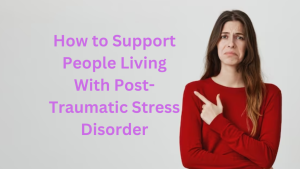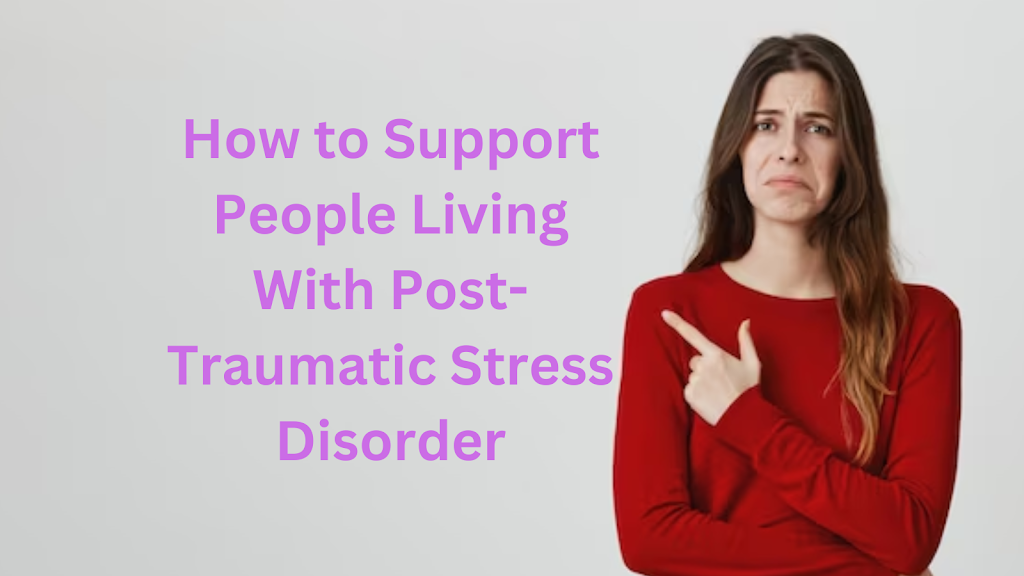How to Support People Living With Post-Traumatic Stress Disorder
It’s not always easy to be the support person when someone you know is living with post-traumatic stress disorder (PTSD). Perhaps it’s a family member, a close friend, or a colleague, and you want to offer your help but don’t know how.
You are not alone in this situation. It can be challenging for those of us not living with PTSD to understand and provide the best level of support for our loved ones. At the same time, we need to be careful not to overstep boundaries or take away from the responsibilities of professional caregivers.
In this article, I’m going to discuss how you can offer meaningful support to people living with PTSD in a way that meets their needs and respects their autonomy. From understanding what PTSD is and its effects on people, to offering practical ways to show we care—let’s cover it all!
What Is Post-Traumatic Stress Disorder?
You might have heard of post-traumatic stress disorder (PTSD), but what exactly is it? PTSD is a mental health condition that can develop after a person experiences or witnesses a traumatic event. Common psychological responses to trauma can include feelings of helplessness, shock, anger, fear, and guilt.
Symptoms of PTSD can be severe and last for months or even years, but the effects vary from person to person. They can include intrusive memories or flashbacks that make it difficult to focus on everyday life; avoiding reminders of the event; increased anxiety and emotions that are easily triggered; problems with sleeping; self-destructive behavior; and more.
 |
| How to Support People Living With Post-Traumatic Stress Disorder |
It’s important to understand how PTSD affects an individual so you know how best to support them. Of course, every situation is unique and it’s important not to make assumptions — inquire about their needs and expectations so you can provide appropriate assistance in the best way possible.
The Symptoms of PTSD
Post-traumatic stress disorder (PTSD) is a mental health condition that can be triggered by experiencing or witnessing a traumatic event. PTSD affects both the mind and body, with symptoms ranging from physical to psychological.
If you’re looking to support someone living with PTSD, it’s important to understand what the symptoms are in order to know how best to offer support. Common symptoms often include:
-
Flashbacks – A sudden and intense recollection of a traumatic event that was experienced in the past.
-
Nightmares – Disturbing dreams often related to the traumatic experience or event.
-
Avoidance – Avoiding reminders or conversations related to the traumatic event can be a sign of PTSD.
-
Emotional numbness – People with PTSD may feel disconnected from their emotions and find it hard to enjoy activities they used to like doing.
-
Hyperarousal – Heightened levels of anxiety and tension accompanied by anger, irritability, sleep disruption, difficulty concentrating, and being easily startled by loud noises or sudden movements.
It’s important to remember that people living with PTSD may experience these symptoms in different ways and they can change over time. It is also possible for them not to have all symptoms at once or have varying degrees of each symptom at different times.
How Can We Support People Living With PTSD?
Living with PTSD can be an extremely challenging and isolating experience, but there are proactive steps we can take to offer our support. Here are some things you can do:
Listen without judgment
The most important thing you can do is to offer a listening ear without being judgemental. People living with PTSD may be struggling to make sense of their experiences and it helps to talk about it. Let them know that you’re here for them if they need it and validate their feelings rather than trying to make them feel better or ‘fix’ their problems.
Encourage positive activities
Suggest positive activities that may help the person feel grounded and in control. Spending time outdoors in nature, exercising, playing sports and engaging in creative activities are all good ideas for people living with PTSD as they provide distraction from intrusive thoughts as well as help lift the person’s mood.
Connect with support groups
Look for available resources such as support groups, therapy or counseling sessions for the person living with PTSD. Support groups provide an opportunity for people to share their experiences with individuals who are facing similar issues, promoting a sense of community and understanding that those struggling with PTSD may not find elsewhere.
Managing Triggers and Responses Associated With PTSD
PTSD can be incredibly hard to manage, and the triggers and responses associated with it can make life really hard. It is important to find ways to manage these triggers and responses in order to help people living with PTSD cope.
Identifying Triggers
The first step in managing triggers associated with PTSD is to identify what those triggers are for the individual. Triggers can be varied, from a certain smell or sound, to a certain person or place. It is important for the individual living with PTSD to take the time to look inward and identify what those triggers might be for them.
Managing Responses
The second step is learning how to manage their responses when faced with a trigger associated with their PTSD. It is important for people living with PTSD to learn coping strategies such as deep breathing exercises or other relaxation techniques in order to calm themselves when they become overwhelmed by their emotions. Additionally, it is important that they get support from friends, family and professionals in order to help them develop healthier coping strategies when faced with stressors related to PTSD.
Implementing Techniques
Lastly, it is important that once the individual living with PTSD has identified their triggers and has developed strategies for managing their responses, they actually commit those techniques into practice. By intentionally implementing techniques regularly, individuals can begin developing better ways of responding when faced with a trigger associated with their PTSD.
Conclusion
Supporting someone with post-traumatic stress disorder can be incredibly rewarding. Knowing you are helping another person through their difficult times and empowering them to seek treatment can make a world of difference. Understanding the causes, symptoms and treatment of PTSD is the first step in being able to provide quality care and support.
People living with PTSD need to be given the opportunity to heal. A compassionate and understanding approach can help create a safe and supportive environment, allowing individuals to process their thoughts and feelings and take back control of their lives. Remember, compassion and patience are the most important tools in helping someone with PTSD.
